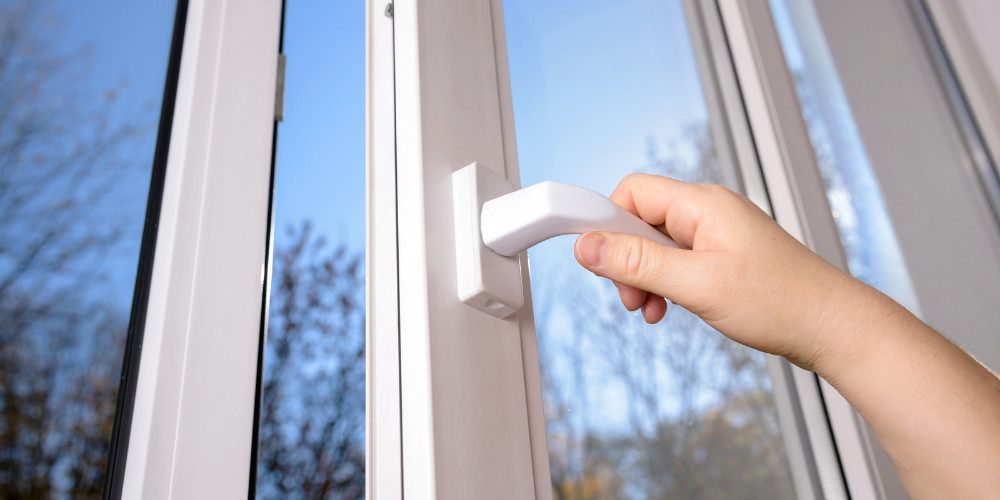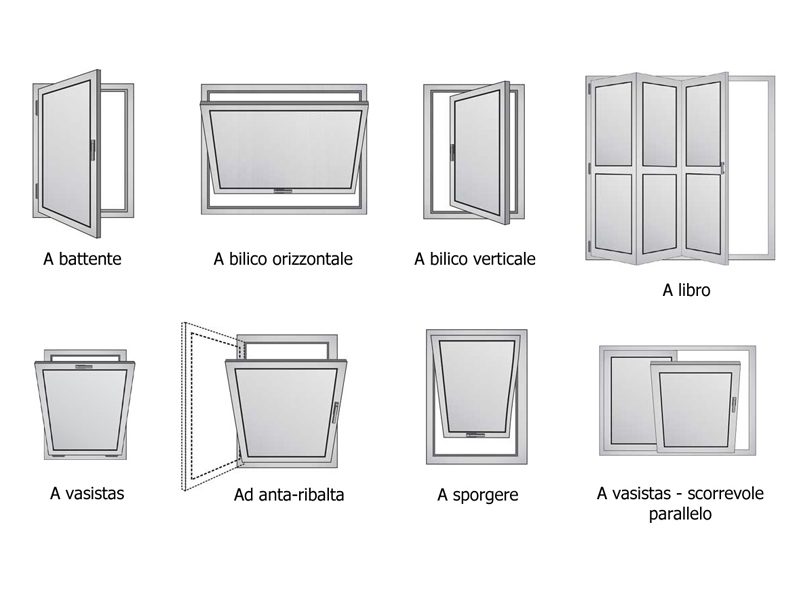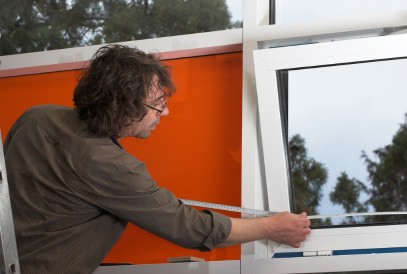Types of window openings: which one is right for your home?
Among the most important elements of the house is the
window , which allows you to isolate from sounds and diffuse the light, keep the heat, ventilate allowing the exchange of air and finally protect the entrances of the houses.
In fact, a house without windows would be unprotected, at the mercy of bad weather, heat in summer and cold in winter. A house without the
access control that the windows offer would be invaded by insects and birds, and prey to any malicious people.
We can make
types of windows with different materials and various possibilities of colors and sizes. Not only. also the
types of window opening are an important choice both aesthetic and functional according to our particular housing needs.
The identification of
the most suitable type of opening is an integral part of the design of the environment. This choice should take into account certain parameters such as use of the window frame, organization of the premises, ventilation and water tightness needs, safety, view, passage, maintenance and cleaning.
Welcome, I'm
Elia Caneppele from the Windowo team and today I'll try to explain the various
types of window openings . I will describe all the possible types of door and window movement that I know, detailing their advantages and disadvantages. I will focus in particular on when to choose one or the other.
 "Sometimes the windows do not have shutters, they open onto horizons much wider than the real ones." - Antonio Tabucchi
"Sometimes the windows do not have shutters, they open onto horizons much wider than the real ones." - Antonio Tabucchi
Choice of window type: what is important to consider?
There are some aspects that are more important than others to consider when choosing the
type of windows for your home. In order for the
doors and windows to guarantee the right thermal and acoustic insulation, it is necessary to make a choice that takes into account:
- Dimensions : according to the needs of ventilation and brightness of the room (we divide between standard and non-standard dimensions);
- Material : windows are normally made of wood, aluminum or pvc;
- Window opening type : based on the movement of the sash, we will see these window movements in detail below;
- Type of glass : double glass, triple glass, selective glass, low-emissivity, reflective, sound-absorbing glass and many other types;
- Style of the building : I am referring to the relationship between windows and facade, which should be as consistent as possible.
How many types of windows are there?
We can start by distinguishing three main
types of fixtures based on the material with which they are made:
- pvc window frames , profiles joined by welding which are waterproof, acoustically and thermally insulating;
- wooden window frames , an excellent material for making doors and windows because it is a natural thermal and acoustic insulator;
- aluminum frames , a material that is easy to work without special machinery, resistant and light.
There are also doors and windows in aluminum and wood, steel, iron and other alloys.
Pvc or aluminum windows? If they are done well, they can both work. We must not be fooled by window sellers who only point the finger at the material. For each of these 3 types, there is not just one way to
open a window , and choosing the most suitable one is perhaps even more important than choosing the material for making the frame.
The
type of opening of a window or door is really fundamental: the level of living comfort is influenced by the lighting, the presence or absence of humidity and the right air exchange. Cleaning the window itself safely is another point that should not be underestimated.
Based on the movement that the door makes during the closing and opening phase, we can make
classifications of the window openings :
- rotational movement;
- translation movement;
- movements of rotation and translation together.
Based on this, let's see together what are the
main types of window openings .
10 types of window opening: strengths and weaknesses
The
type of window opening , in particular the movement performed by the moving parts during opening, determines the performance offered by the window itself.
The shape derives from the type of window : the size of the doors, their morphology, the rebate of the frame and the shape of the profiles to guarantee closure.
In choosing the most suitable window frame, various factors must be taken into account:
- dimensional limits of the doors in relation to the type of opening;
- planning and visibility needs;
- natural ventilation needs;
- need for air and water tightness;
- furnishing needs of the premises;
- maneuverability requirements of the window frame;
- presence of shading screens;
- cleaning and maintenance needs.
Below, the drawings showing different
window opening systems .

1 - Frame with fixed door: no type of movement
Let's start with the family of doors, even if the
fixed door is not a real opening in the strict sense.
Simple to make, the fixed door is a luminous type with a very low cost. In fact, the fixed door ensures
great visibility : the dimensional limit coincides only with that of the glass plate.
Normally the fixed door is used to create curtain walls in glass. For maintenance and cleaning, the faces must be accessible from entrances, especially if they are large.
2 - Windows with hinged door opening
The
hinged door opens with a rotation movement on a lateral vertical axis towards the inside of the room. The hinged opening is the most used system in Italy: it is the classic opening. We can distinguish between
internal and
external sash , depending on the opening direction.
In the types of window openings with hinged doors, the doors take on an elongated shape vertically, also to limit the encumbrance during the opening phase and to contain static stresses. These doors can be combined in pairs, not necessarily of the same size. It is possible to create multiple leaves, but as the number of leaves increases, there is a deterioration in performance.
The dimension of the hinged door depends on the possibility or not of internal dimensions in case of opening and on the need to contain the weight of the door on hinges and hinges. The vertical stop between the two doors implies a considerable visual encumbrance.
The hinged doors do not allow the regulation of the ventilation in the absence of mechanisms that regulate the opening in intermediate positions. It allows the almost total opening of the compartment. The air tightness is ensured by the presence of stops in several points equipped with gaskets.
It allows the creation of French windows, in this case the horizontal crosspiece is replaced by the threshold.
Pros and cons of casement windows:
Advantages:
- free compartment with doors in the open position;
- ease of door movement;
- excellent air and water tightness.
Defects:
- the vertical stop between the doors is an obstacle to the view;
- difficulty in cleaning due to outward opening doors and single door;
- difficulty in regulating the air
- the doors that open outwards cause clutter and hinder the shading systems.
3 - Tilt-and-turn windows: with flap opening
The vasistas opening allows a rotating opening movement around the lower horizontal axis. It allows only a
partial opening because it only opens with a slot in the upper part of the window. It does not allow the opening of the windowed compartment but, on the other hand, has a minimal footprint.
There are two types of vasistas opening:
- internal vasistas , internal flap;
- external vasistas, external flap.
Tilt-and-turn windows are suitable for satisfying limited ventilation needs (if not combined with other types). This is why they are suitable for those rooms, such as cellars or skylights, where there is the need to ventilate without the need for a view. The small opening angle allows you to maintain a continuous exchange of air without having to open the windows and create strong temperature changes.
It is difficult to clean externally, as the transom windows do not allow the possibility of looking out (there are systems that allow you to release the upper arm to allow cleaning of the external side). Furthermore, the maneuvering difficulties increase as the opening angle and the size of the door increase.
I have already dealt with vasistas windows in depth, if you are interested look for the dedicated article in the
Windowo blog .
Pros and cons of transom window openings:
Advantages:
- continuous ventilation of the rooms;
- freedom of door geometry;
- small internal dimensions of the premises;
- easy maneuver;
- possibility of being combined with other systems.
Defects:
- weight of the door weighing on the hinges;
- passage and view blocked;
- difficulty cleaning.
4 - Tilt-and-turn or oscillobattente windows
The flap door has a
double opening movement : it rotates on the lateral vertical axis and on the lower horizontal axis. This system is very popular today because it combines the two solutions which are formed by a hinged door and a bottom hinged door.
The same door can be opened both as hinged and as vasistas, controlling the movement with the different positions that the handle can assume with very easy commands. On Windowo you can find
dk handles for bottom hinged windows for sale online at discounted prices.
The advantages of the door are combined with those of the vasistas, practically eliminating its defects. Thus there is little space in the opening and it is possible to ventilate a room quickly.
The window must use
high quality hardware for windows because the passage from one movement to another could lead to the release of the hinges.
Pros and cons of tilt-and-turn windows:
Advantages:
- excellent ventilation;
- excellent view due to the absence of intermediate vertical uprights;
- ease of movement;
- easy external cleaning and maintenance;
- it does not hinder external shading systems.
Defects:
- it can hinder internal darkening systems;
- the hinges are delicate in switching from one ace of rotation to the other.
5 - Vertical pivot and horizontal pivot
The pivot door consists of a single glass panel that opens with a movement around an axis, generally placed in the center of the window.
The windows with pivot opening open quickly and easily, guaranteeing air exchange. This is because the pivot unit allows the internal stale air to exit from the bottom and the clean air to enter from the outside.
The pivot windows have possible critical points in correspondence with the axes where the rotation takes place, with the risk of decreased performance. The clutter inside and outside can compromise the possibility of adding screens to the window.
Pros and cons of pivot window openings:
Advantages:
- possibility of creating large lights;
- excellent ventilation;
- easy maneuvering and handling;
- simple maintenance and cleaning;
- good visibility with the door closed.
Defects:
- reduced passage;
- difficulty in locking and dangerousness of opening;
- interference with darkening systems;
- internal and external dimensions;
- delicacy of the pin and difficulty of adjustment.
6 - Horizontal and vertical sliding door
This type of opening takes place by means of a horizontal or vertical translation movement. The
sliding opening has considerable advantages, especially in the construction of large windows. In fact, the overall dimensions of the premises are zero, the view is excellent, the maneuverability is easy.
Air and water tightness is guaranteed by the use of excellent gaskets.
The considerable dimensions of the glass are combined with the slim shape of the profiles (thanks to the immediate support of the weight of the sliding part on the fixed frame).
The sliding window can be:
Lift and slide , consisting of a fixed door and another that rises and slides in parallel. The rotation of the
lift and slide handles allows the maneuver because it allows lifting and translation. When closing, the sash lowers again, the gaskets press against the sliding tracks and create the seal. Thus it ensures a great seal against air, water and wind.
Parallel sliding , which ensures excellent resistance to atmospheric agents. This system guarantees high lighting and good insulation, combined with the ability to ventilate quickly.
Pros and cons of the sliding window:
Advantages:
- easy maneuvering even with large doors;
- possibility of locking the door in intermediate positions;
- absence of interference with darkening systems;
- good air and water tightness;
Defects:
- passage forbidden by lower rail or door;
- cleaning and maintenance accessible from the outside;
- the running tracks can become dirty.
7 - Compass door
When the movement of the door takes place on the upper horizontal axis towards the inside, it is called an internal compass, otherwise if it is towards the outside it is called an external compass. The hinges hold the entire weight of the door, so they must be of the right size.
Pros and cons of opening the window with a compass door:
Advantages:
- excellent ventilation;
- opening angle adjustment.
Defects:
- difficulty in maneuvering for large doors;
- fragility of the hinges;
- forbidden passage;
- cleaning and maintenance from outside;
- interference with darkening systems.
8 - Guillotine opening
Among the types of windows, the sash opening, or up and
down , is a frame with various parts that slide vertically. It is rarely used in Italy. This window opening is very popular with the French (I'm kidding of course!).
There are many solutions made with this guillotine system, with an acceptable performance / cost ratio. Abroad it is often used in hotels or restaurants.
9 - Outward opening
The top
hung window belongs to the sash family and has the same excellent thermal and acoustic performance (see above).
It is possible to create types of windows with large openings equipped with a single glass with protruding movement. However, it is rarely used because it has the same limits as pivot openings (see what we said earlier).
10 - Opening with folding door (package)
The doors and windows with folding opening, also called folding or package, have a double opening mechanism: they rotate around a vertical axis and also have a horizontal translation. For this reason it is also called accordion.
The system consists of at least two doors connected to each other by hinges that allow translation on upper or lower horizontal tracks. Depending on where the pivot for rotation on the vertical axis is positioned, the door changes definition:
- folding door : pin placed at the edge of the door;
- accordion door : pivot in a central position on the lower crosspiece of the door.
Each single door is hinged on a trolley that runs on a track. The folding door reduces the overall space compared to a hinged door and has a strong resistance to the wind. The reduced number of fastening points to the fixed frame and the numerous hinges can cause air and water infiltrations.
The opening maneuver is easy, as long as good carriages and sliding tracks are used and if these are kept clean.
10 + 1 - Extra - Types of motorized openings
If you wish, it is possible to motorize all the types of openings that we have seen.
This way you can remove the
handles because the opening will be attributed to the
window motors . The latter can be retractable and controlled by a button or
opening with a smartphone .
Conclusions on the types of window openings
I want to conclude by placing your attention on the fact that each window opening has, as we have seen, its own advantages and disadvantages.
A good designer or consultant has the task of advising you on the most suitable solution for your home and your goals.
Among your primary objectives you can place your attention in particular:
- To thermal insulation;
- To sound insulation;
- To air permeability;
- To anti-burglary security;
- To the brightness;
- To design.
I recommend: get
advice from a professional who is attentive to your specific needs.
"As long as there are windows, the humblest human being on earth will have his share of freedom." - Amélie Nothomb


